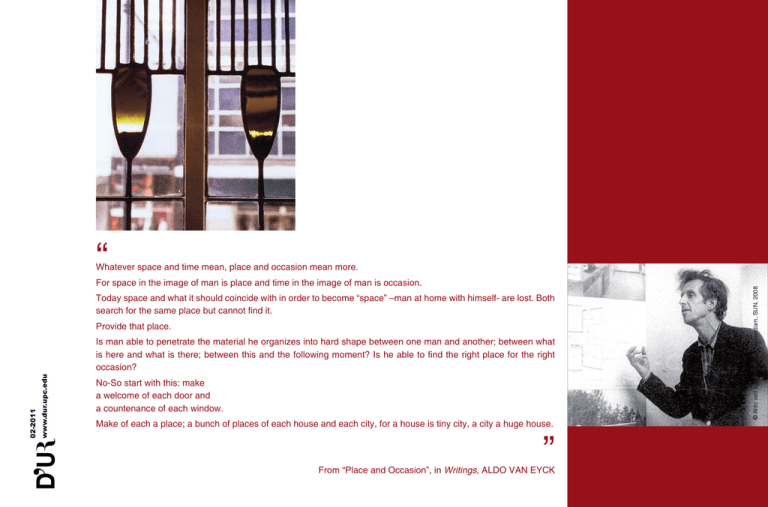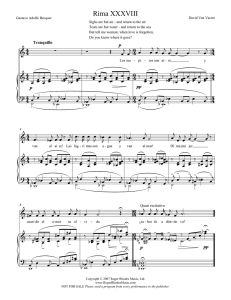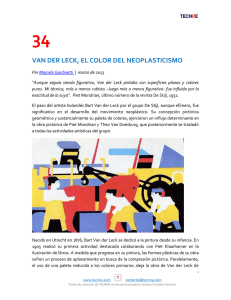Page 1 Whatever space and time mean, place and occasion mean
Anuncio

“ For space in the image of man is place and time in the image of man is occasion. Today space and what it should coincide with in order to become “space” –man at home with himself- are lost. Both search for the same place but cannot find it. Provide that place. www.dur.upc.edu 02-2011 Is man able to penetrate the material he organizes into hard shape between one man and another; between what is here and what is there; between this and the following moment? Is he able to find the right place for the right occasion? No-So start with this: make a welcome of each door and a countenance of each window. Make of each a place; a bunch of places of each house and each city, for a house is tiny city, a city a huge house. ” From “Place and Occasion”, in Writings, ALDO VAN EYCK © Aldo van Eyck Writings, Amsterdam, SUN, 2008 Whatever space and time mean, place and occasion mean more. Regarding Aldo Van Eyck; The enigma of size. Urbino, 1979 96 Aldo van Eyck remains far less recognized, on the other hand, and he has a notably different profile. His writings are more complex and poetic, his architecture subtler, more subdued. Van Eyck’s approach to urbanism and the historical imperatives of his time—namely the rebuilding of postwar Europe—was more functional, and in its own way, more belligerent. I can still recall the effect his lecture, “The Enigma of Size,” had on us that summer, one of great puzzlement. His presentation seemed at the time a random collection of pointed observations, a travelogue, something wholly foreign to architecture as we then understood it, and we simply weren’t prepared to assimilate what he was trying to tell us. But today, thirty-odd years on, it seems to me that his intuitions, preoccupations and designs remain as provocative as ever. Van Eyck, the humanist, the anthropologist, the artist and poet continues to astonish us with his intricate and challenging writings, to make us think and smile with his brilliant maxims. He moves us equally in the orphanages, the churches and the “playgrounds” with his singularly unrestrained and probing outlook upon the city. The city understood as an oversized household. Translation: Philip Kay During the summer of 1979 Peter Smithson and Aldo van Eyck served as the ILAUD’s Visiting Critics. Of the two, Smithson is better known today, thanks to his extraordinary intuition and organizational skills and to the authority of his collaborator and wife Alison Smithson. The Smithsons’ manuscripts have, for the most part, found publishers, and a number of their designs have been widely disseminated, among them the Golden Lane Estate, The Economist building in London and their plan for Berlin. www.dur.upc.edu In 1976 in the city of Urbino, Giancarlo de Carlo set up the International Laboratory of Architecture and Urban Design (ILAUD), the first workshop of its kind for architects from across Europe. For de Carlo and the other architects assembled in what was known as Team 10, the new lab represented a chance to spend the month of August pooling their energies and putting their ideas into practice by focusing on a common project. It was also a pretext for expanding upon the shared preoccupations and designs of the Congrès internationaux d’architecture moderne (CIAM)—to which they were all very much indebted—by contributing historical context and new layers of complexity and collaboration. 02-2010 Maria Rubert A propósito de Aldo Van Eyck; The enigma of size. Urbino, 1979 © Aldo van Eyck Writings, Amsterdam, SUN, 2008 https://upcommons.upc.edu/video/handle/2099.2/2053 En la ciudad de Urbino, Gian Carlo de Carlo organizó el primer workshop internacional de arquitectos europeos: el Ilaud (International Laboratory of Architecture and Urban Design). Una ocasión para poner en común y practicar, en torno a un proyecto, los temas que preocupaban a los arquitectos agrupados en torno al Team X. Una excusa para, durante un mes -agosto-, seguir de otro modo las discusiones y la puesta en común de preocupaciones e intenciones del grupo de arquitectos que se sentían deudores del CIAM, pero con el compromiso de ampliar los horizontes de los pioneros incorporando contexto, historia, complejidad, participación, etc. www.dur.upc.edu 02-2010 El curso 1979 los Visiting Critics y conferenciantes del Ilaud fueron Peter Smithson y Aldo Van Eyck. Smithson es más conocido, gracias a su tremenda intuición y a la capacidad organizativa y la autoridad de Alison. Sus manuscritos han sido publicados y tiene buena parte de su archivo divulgado. Golden Lane, el Economist en Londres o su propuesta para Berlín forman parte de la iconografía de referencia. Aldo Van Eyck es más desconocido. Sus textos son más complejos, más poéticos. Su arquitectura más callada, más sutil. Su actitud frente al momento histórico -la reconstrucción europea-, respecto al urbanismo, más funcional, más beligerante. Sin duda, tiene otro perfil. 1,2. Burgerweeshuis (orfanato municipal) en Amsterdam (1955-60) 1,2. Burgerweeshuis (Children’s Home) in Amsterdam (1955-60) Recuerdo el impacto que nos produjo su conferencia “The enigma of size”. No entendimos lo que nos estaba contando. Nos parecían entonces unos comentarios agudos, un pase de diapositivas de sus viajes; algo ajeno a la arquitectura. Treinta años después me parece que las intuiciones, intereses y proyectos de Van Eyck siguen ahí, tan interesantes como entonces no supimos comprender. El Van Eyck humanista interesado por la antropología, por el arte, poeta, sorprende en sus complejos y difíciles textos, hace pensar y sonreír en sus brillantes máximas y aforismos. Emociona en el orfanato, en las iglesias y en los “playgrounds”. Una mirada particular, libre y curiosa a la ciudad, entendida como una gran casa. 97


